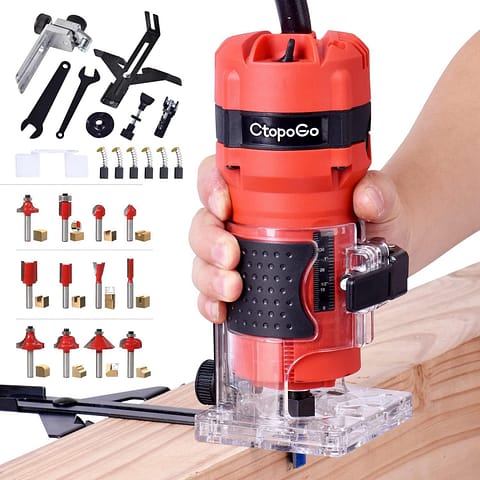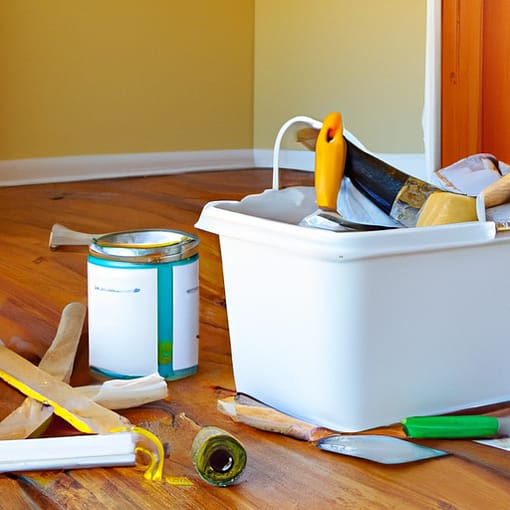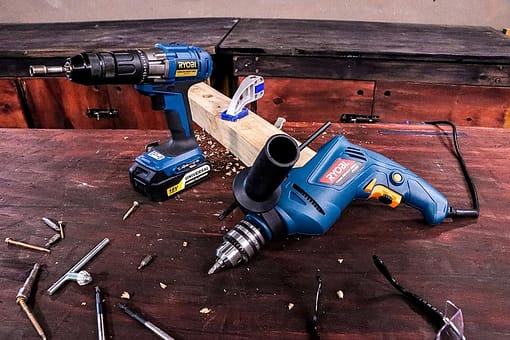So you’ve always been a handy person, someone who loves to make, fix, and create things with your own two hands. And now you’re wondering how you can make an enjoyable living from DIY. Well, you’re in luck! In this article, we’re going to explore exactly how you can make a living from DIY. From crafting and woodworking to home renovations and upcycling, we’ll dive into the various avenues you can pursue to turn your DIY skills into a profitable venture. So grab your toolbox and get ready to learn how to make your passion pay the bills.

Turning DIY into a Business
Have you ever considered turning your DIY skills into a legitimate business? If you’re passionate about creating things with your hands and have a knack for DIY projects, there are numerous opportunities for you to monetize your talents. In this article, we will guide you through the process of establishing a successful DIY business, whether it’s selling products, providing services, teaching skills, creating content, building a community, collaborating with brands, or even writing DIY books. Let’s dive in!
Identifying Your DIY Skills
The first step in turning your DIY hobbies into a business is to identify your core skillset. Take some time to reflect on the areas where you excel and enjoy working on. Are you skilled in woodworking, home decor, sewing, painting, or perhaps upcycling old furniture? It’s crucial to recognize your strengths and passions, as they will form the foundation of your business and help you stand out in a crowded market.
Choosing the Right DIY Niche
Once you have identified your skills, it’s time to narrow down your focus and choose a specific DIY niche. Research the market to understand the demand and competition in different areas. For example, if you’re skilled at creating handmade jewelry, you may want to specialize in a particular type or style of jewelry, such as bohemian or minimalist designs. By niching down, you’ll be able to target a specific audience and establish yourself as an expert in that niche.
Researching the Market
Before diving headfirst into your DIY business, you need to conduct thorough market research. This will help you gain insights into customer preferences, trends, and pricing strategies. Look for existing businesses in your chosen niche and analyze their offerings, branding, and customer reviews. Understanding the market landscape will enable you to make informed decisions and find unique selling points that set your business apart.

Creating a Business Plan
To ensure the success and long-term viability of your DIY business, it’s essential to create a detailed business plan. This document will outline your objectives, target market, marketing strategies, budgeting, and financial projections. A well-crafted business plan will serve as a roadmap for your venture and help you stay focused on your goals. Seek guidance from business mentors or utilize online resources to assist you in creating a comprehensive business plan.
Selling DIY Products
If you enjoy creating physical products and want to sell them, this section will guide you through the process of turning your DIY projects into marketable products.
Creating Unique DIY Products
When it comes to selling DIY products, standing out from the competition is crucial. Put your own creative spin on your products and strive to offer something unique. Explore different materials, colors, designs, and techniques to create one-of-a-kind pieces that will draw in customers. Experimentation and innovation are key to developing a successful DIY product line.
Pricing Your DIY Products
Determining the right pricing for your DIY products can be challenging. Consider factors such as your production costs, time investment, and the perceived value of your creations. Research similar products in the market and gauge their pricing to help you establish a competitive yet profitable price point. It’s important to strike a balance between affordability for customers and sustainability for your business.
Marketing and Selling Channels
Now that you have your DIY products ready, it’s time to market and sell them effectively. Utilize various channels to reach your target audience, such as online marketplaces, social media platforms, and your own website or e-commerce store. Showcase high-quality product images, write engaging descriptions, and leverage social media influencers and online communities to promote your offerings. Engage with customers through excellent customer service and provide a seamless purchasing experience.
Managing Inventory and Fulfillment
As your sales grow, it’s crucial to have a streamlined system in place for inventory management and fulfillment. Keep track of your stock levels, reorder materials in advance, and ensure prompt delivery to maintain customer satisfaction. Consider utilizing inventory management software or outsourcing fulfillment to third-party logistics services to optimize efficiency and focus on growing your business.
Providing DIY Services
If creating and selling physical products isn’t your cup of tea, providing DIY services can be a profitable alternative. Whether it’s offering custom-made items, home improvement services, or personalization services, this section will help you establish and market your DIY service offerings.
Determining Your DIY Service
Think about your skills and how they can be translated into services that customers may need. Are you an expert in home organization, interior design, or event planning? Identify the services you can confidently provide and that align with your passion. Offering specialized services can help you differentiate yourself and appeal to a specific target market.
Setting Competitive Pricing
Pricing your DIY services can be challenging, as they are often intangible and subjective. Research the market to understand the average pricing for similar services and consider your skill level, experience, and the value you offer to clients. Offering different service packages with varying price points can accommodate a wider range of customers and budgets.
Promoting Your DIY Services
To effectively promote your DIY services, utilize both online and offline marketing strategies. Create a professional website or portfolio showcasing your skills, previous projects, and testimonials from satisfied clients. Use social media platforms and online directories to build your online presence and attract potential customers. Collaborate with complementary businesses or attend local events to network and gain exposure. Word-of-mouth referrals can also be a powerful marketing tool for DIY services.
Offering Excellent Customer Service
Providing excellent customer service is paramount when offering DIY services. Clearly communicate with your clients, listen to their needs, and deliver on their expectations. Offer personalized recommendations, be responsive to inquiries, and provide detailed quotations and invoices. Going the extra mile for your customers and ensuring their satisfaction will not only lead to repeat business but also generate positive reviews and referrals.
Teaching DIY Skills
If you have a passion for sharing knowledge and helping others learn, teaching DIY skills can be a fulfilling and profitable endeavor. This section will guide you through the process of identifying teachable DIY skills and creating engaging educational opportunities.
Identifying Teachable DIY Skills
Consider the DIY skills you excel at and assess their teachability. Is there a demand for learning those skills? Start by teaching basic techniques and gradually progress to more advanced levels. Research online communities, forums, and social media groups to understand the interests and needs of individuals seeking to learn DIY skills.
Planning and Structuring DIY Workshops
When planning DIY workshops, focus on creating a structured curriculum that guides participants from beginner to proficient levels. Consider the duration, location, and availability of materials and tools. Prepare step-by-step instructions, handouts, and visual aids to assist participants in grasping the concepts. Make sure to offer a welcoming and supportive environment where participants can ask questions and receive individual attention if needed.
Setting Up a DIY Online Course
Offering online courses allows you to reach a broader audience and provide flexible learning options. Consider platforms such as Udemy, Teachable, or Skillshare to host and sell your DIY courses. Develop engaging video content, printable resources, and interactive elements to enhance your online course. Create a community where students can interact, seek feedback, and share their projects to foster a sense of belonging and growth.
Promoting and Marketing Your DIY Classes
To effectively promote your DIY classes, leverage both online and offline marketing channels. Establish a professional website or landing page dedicated to your classes, complete with detailed course descriptions, testimonials, and a straightforward enrollment process. Utilize social media platforms, email marketing, and digital advertising to reach your target audience. Offer introductory discounts or referral incentives to encourage enrollment and reward loyal students.
Creating DIY How-To Content
If you enjoy creating content and have a flair for teaching, leveraging DIY how-to content can be a lucrative way to monetize your skills. This section will guide you through the process of choosing the right platform, creating engaging tutorials, optimizing content for search engines, and generating revenue.
Choosing the Right DIY Platform
Choose a platform that aligns with your goals and target audience. Consider starting a blog, hosting a YouTube channel, or creating content on social media platforms such as Instagram or TikTok. Research the platforms most popular in your niche and assess their user base, engagement levels, and monetization options. Select a platform that allows you to showcase your creativity and expertise effectively.
Creating Engaging DIY Tutorials
When creating DIY tutorials, focus on providing clear instructions, step-by-step visuals, and concise explanations. Use high-quality images or videos to demonstrate the process, and include a list of necessary materials and tools. Break down complex tasks into manageable steps and encourage viewers to ask questions or leave comments for clarification. Make your content relatable and inspire your audience to try the projects themselves.
Optimizing DIY Content for Search Engines
To increase the visibility and reach of your DIY content, optimize it for search engines. Conduct keyword research to identify the search terms that potential viewers are using. Incorporate these keywords naturally within your content, including in your titles, descriptions, headers, and image alt tags. Develop a consistent posting schedule to build traction and improve your search engine rankings over time.
Monetizing DIY Content
Once you have built a substantial audience and established yourself as a trusted source of DIY content, explore various monetization strategies. Consider partnering with brands for sponsored content, joining affiliate marketing programs, or offering premium content or digital products for purchase. Explore crowdfunding platforms like Patreon to allow your audience to support your work and gain access to exclusive perks.
Building an Online DIY Community
Building an engaged community of like-minded individuals is invaluable for a successful DIY business. This section will guide you through the process of identifying your target audience, creating a DIY blog or website, engaging with your community, and generating revenue.
Identifying Your Target Audience
Understanding your target audience is essential when building an online DIY community. Consider their demographics, interests, skill levels, and pain points. Conduct surveys or engage in conversations to get to know your audience better. By tailoring your content and engagement strategies to their needs, you can build a vibrant and loyal community.
Creating a DIY Blog or Website
Establishing a blog or website dedicated to DIY content can serve as a hub for your online community. Provide valuable resources, tutorials, and inspiration for your audience to enjoy. Develop a visually appealing and user-friendly website, optimize it for search engines, and ensure it is responsive on different devices. Encourage community engagement through comments, forums, or even user-generated content.
Engaging with Your DIY Community
To keep your DIY community engaged, foster meaningful interactions and provide valuable content regularly. Respond to comments, address questions, and encourage discussions on your blog or social media platforms. Organize contests, challenges, or collaborations to encourage community participation and showcase the talents of your members. Consider hosting live events, webinars, or Q&A sessions to encourage real-time interactions.
Generating Revenue from Your DIY Community
Building a thriving DIY community offers various opportunities for generating revenue. Explore partnering with complementary brands or businesses for sponsored content or guest posts. Consider hosting paid workshops or classes exclusively for community members. Monetize your community by offering premium memberships, access to exclusive content, or even selling merchandise with your brand logo.
Collaborating with Brands and Influencers
Collaborating with brands and influencers can help you expand your reach, gain credibility, and access new customer segments. This section will guide you through the process of building a strong DIY brand, approaching potential collaborators, negotiating collaborations, and creating win-win partnerships.
Building a Strong DIY Brand
Developing a strong DIY brand is essential for attracting collaborations with brands and influencers. Define your brand identity, core values, and unique selling proposition. Build a visually cohesive brand presence across your website, social media platforms, and content. Establish your expertise and credibility by consistently delivering high-quality DIY content and engaging with your audience.
Approaching Brands and Influencers
When approaching brands and influencers for collaborations, it’s important to research their values, target audience, and previous collaborations. Personalize your outreach messages to show that you have done your homework and genuinely believe in the collaboration. Clearly articulate the benefits and unique value you can bring to their brand or audience. Be prepared to showcase examples of your previous work and highlight any relevant metrics or success stories.
Negotiating Collaborations and Sponsorships
When negotiating collaborations and sponsorships, focus on creating a win-win partnership that benefits both parties. Clearly define the scope of the collaboration, deliverables, and expectations. Discuss the compensation or exchange of value, whether it’s monetary compensation, free products, exposure, or cross-promotion. Document the agreed terms in a written contract to ensure clarity and avoid any misunderstandings.
Creating Win-Win Partnerships
To create successful collaborations, it’s important to nurture and maintain a positive relationship with brands and influencers. Deliver your commitments on time and to a high standard. Follow up with thank-you messages or even testimonials to show your appreciation. Actively promote the collaboration across your channels and engage with the brand or influencer’s audience. By demonstrating professionalism and reciprocity, you can create long-lasting partnerships.
Selling DIY E-books and Guides
If you have a wealth of DIY knowledge and want to share it with a wider audience, creating DIY e-books and guides can be a profitable avenue. This section will guide you through the process of choosing the right DIY topic, writing and formatting e-books, creating guides and templates, and effectively promoting and selling them.
Choosing the Right DIY Topic
When selecting a DIY topic for your e-book or guide, consider the demand for that particular skill or project. Research popular trends, frequently asked questions, and areas where people commonly seek guidance. Choose a topic that aligns with your expertise and passion while ensuring that there is a market for it. Cater to both beginners and more experienced DIY enthusiasts to maximize your potential audience.
Writing and Formatting DIY E-books
When writing DIY e-books, structure the content in a logical and easy-to-follow manner. Break down the steps, provide clear instructions, and include visual references, such as images or diagrams, to aid understanding. Consider using professional design software or hiring a designer to create visually appealing layouts that enhance the reading experience. Ensure that the e-book is compatible with various devices and formats for accessibility.
Creating DIY Guides and Templates
In addition to e-books, creating DIY guides and templates can be a valuable resource for your audience. Develop comprehensive step-by-step guides or downloadable templates that provide practical assistance for specific DIY projects or tasks. Offer both free and premium options to cater to different audience segments, and consider bundling related guides or templates to provide even more value for your customers.
Promoting and Selling DIY E-books
To effectively promote and sell your DIY e-books, leverage your existing online presence and engage with your target audience. Write compelling blog posts or create videos that provide a glimpse of the valuable content in your e-book. Offer exclusive discounts or bonuses to incentivize purchases. Utilize email marketing, social media campaigns, and collaborations with influencers or complementary brands to increase visibility and reach.
Providing DIY Consultation
If you have extensive DIY knowledge and practical experience, offering DIY consultation services can be a valuable source of income. This section will guide you through the process of identifying your DIY consultation niche, setting consulting rates, marketing and networking, and delivering value to your clients.
Identifying Your DIY Consultation Niche
Identify a specific DIY consultation niche based on your expertise and the needs of potential clients. Focus on areas where you can provide valuable insights, personalized advice, and problem-solving. Whether it’s assisting with home renovation projects, providing guidance on specific crafts, or offering creative direction, narrowing down your niche will help you attract the right clients and position yourself as an expert.
Setting Consulting Rates
Determining your consulting rates can be challenging, as it depends on factors such as your experience, expertise, and the value you provide to clients. Research industry standards, consider your target market’s ability to pay, and assess the demand for your services. Initially, you may need to offer competitive rates or introductory discounts to attract clients and build your reputation. As you gain experience and recognition, you can gradually increase your rates.
Marketing and Networking for DIY Consultation
To effectively market your DIY consultation services, leverage both online and offline strategies. Develop a professional website or landing page that showcases your expertise, client testimonials, and case studies. Utilize social media platforms and professional networks to engage with your target audience and share valuable content. Attend industry conferences, trade shows, or local events to network with potential clients and build relationships.
Delivering Value in DIY Consultation
When providing DIY consultation services, always go above and beyond to deliver value to your clients. Understand their objectives, needs, and limitations, and tailor your advice and recommendations accordingly. Provide practical solutions, actionable steps, and ongoing support to ensure their success. Continuously improve your knowledge and stay up-to-date with industry trends to offer the most relevant and valuable insights.
Scaling Your DIY Business
If you’re looking to take your DIY business to the next level, scaling is the key. This section will guide you through strategies for outsourcing and automating DIY processes, expanding your offerings, collaborating with other DIY entrepreneurs, and growing your customer base.
Outsourcing and Automating DIY Processes
As your DIY business grows, it may become necessary to outsource certain tasks or automate processes to maximize efficiency. Identify areas of your business where outsourcing would be beneficial, such as production, packaging, or customer service. Consider hiring virtual assistants, partnering with fulfillment centers, or utilizing software tools to streamline your operations and free up your time for other crucial aspects of your business.
Expanding Your DIY Business Offerings
To attract new customers and increase revenue, consider expanding your DIY business offerings. Identify complementary products or services that align with your brand and target audience. For example, if you currently sell handmade jewelry, you may expand into selling jewelry-making supplies or offering jewelry repair services. Research the demand for these offerings and adapt your business model accordingly, ensuring that it aligns with your core values and expertise.
Collaborating with Other DIY Entrepreneurs
Collaborating with fellow DIY entrepreneurs can be mutually beneficial and help you tap into new customer segments. Identify entrepreneurs in related niches or with complementary skills and explore collaborative opportunities. This can include joint marketing campaigns, co-hosting workshops or events, or creating exclusive product bundles. Collaborating with others not only expands your reach but also allows you to learn and grow from each other’s expertise.
Growing Your Customer Base
To grow your DIY business, it’s essential to continuously expand and diversify your customer base. Utilize targeted online advertisements to reach new audiences who may be interested in your products or services. Offer referral incentives or loyalty programs to encourage existing customers to refer their friends and family. Seek partnerships with influencers or bloggers who have access to your target market. By consistently increasing your customer base, you can secure long-term success for your DIY business.
Conclusion
With the right skills, market research, and a solid business plan, you can turn your DIY talents into a profitable venture. Whether you choose to sell products, provide services, teach skills, create content, build a community, collaborate with brands, write DIY books, offer consultation, or scale your business, there are endless opportunities to make a living from DIY. Remember to stay true to your passion, continuously refine your craft, and always prioritize the satisfaction and value you provide to your customers. Embrace the journey, learn from challenges, and enjoy the fulfilment of turning your DIY dreams into a thriving business.













